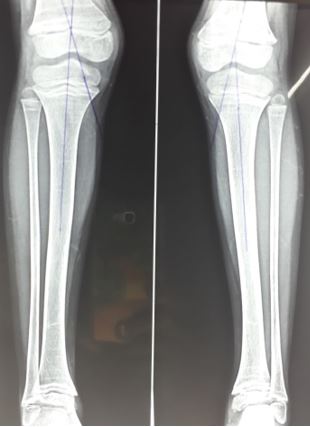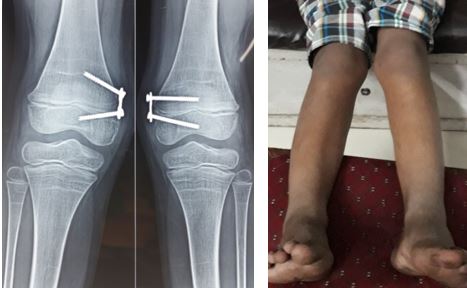Eight Plate Hemiepiphysiodesis In Genu Valgum: A Retrospective Study
Choubey R1*, Jain R2, Gupta A3
1* Raghvendra Choubey, Associate Professor Department of Orthopaedics, Bundelkand Medical College, Sagar, MP, India.
2 R Jain, Associate Professor Department of Orthopaedics, Bundelkand Medical College, Sagar, MP, India.
3 A Gupta, Associate Professor Department of Orthopaedics, Bundelkand Medical College, Sagar, MP, India.
Background: Angular deformities of distal femur can be treated with corrective osteotomies and skeletal fixation. In children, this major intervention can be avoided with temporary hemiepiphysiodesis. Recently, a new implant called the eight-Plate, consisting of a two-hole plate and two screws, is popular as an alternative to the Blount staple to perform temporary hemiepiphysiodesis in children.
Materials and Methods: Fifteen patients (16 physes, 16 limbs) were identified retrospectively in between November 2012 to September 2017 who underwent eight plate surgical growth modulation with average follow-up after plate insertion of 2 years 2 months (range, 1 year 6 months to 2 years 6 months).
Results: Average age at eight-Plate implantation was eleven years three months (age range, 9 years 8 months to 13 years 6 months). Eight-plates were inserted for an average 14.0 months (range, 11.0–20.4 months). No growth disturbance was observed. Mechanical lateral distal femoral angle changed an average 10.00 degrees (range, 7–18 degrees) or 0.4 degrees/month.
Conclusions: The eight-Plate effectively treats angular deformities in growing children and is less likely to extrude spontaneously than the Blount staple. We have not observed growth disturbance or other complications related to this device.
Keywords: Eight-Plate, Guided growth, Hemiepiphysiodesis
| Corresponding Author | How to Cite this Article | To Browse |
|---|---|---|
| , , Associate Professor Department of Orthopaedics, Bundelkand Medical College, Sagar, MP, India. Email: |
Choubey R, Jain R, Gupta A, Eight Plate Hemiepiphysiodesis In Genu Valgum: A Retrospective Study. ojmpc. 2019;25(1):30-33. Available From https://ojmpc.com/index.php/ojmpc/article/view/74 |




